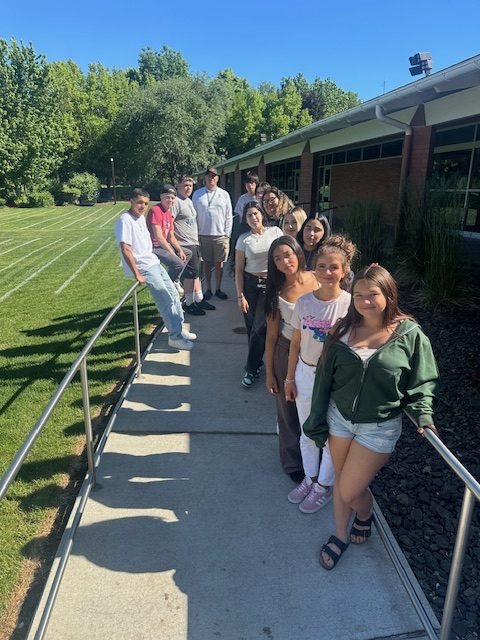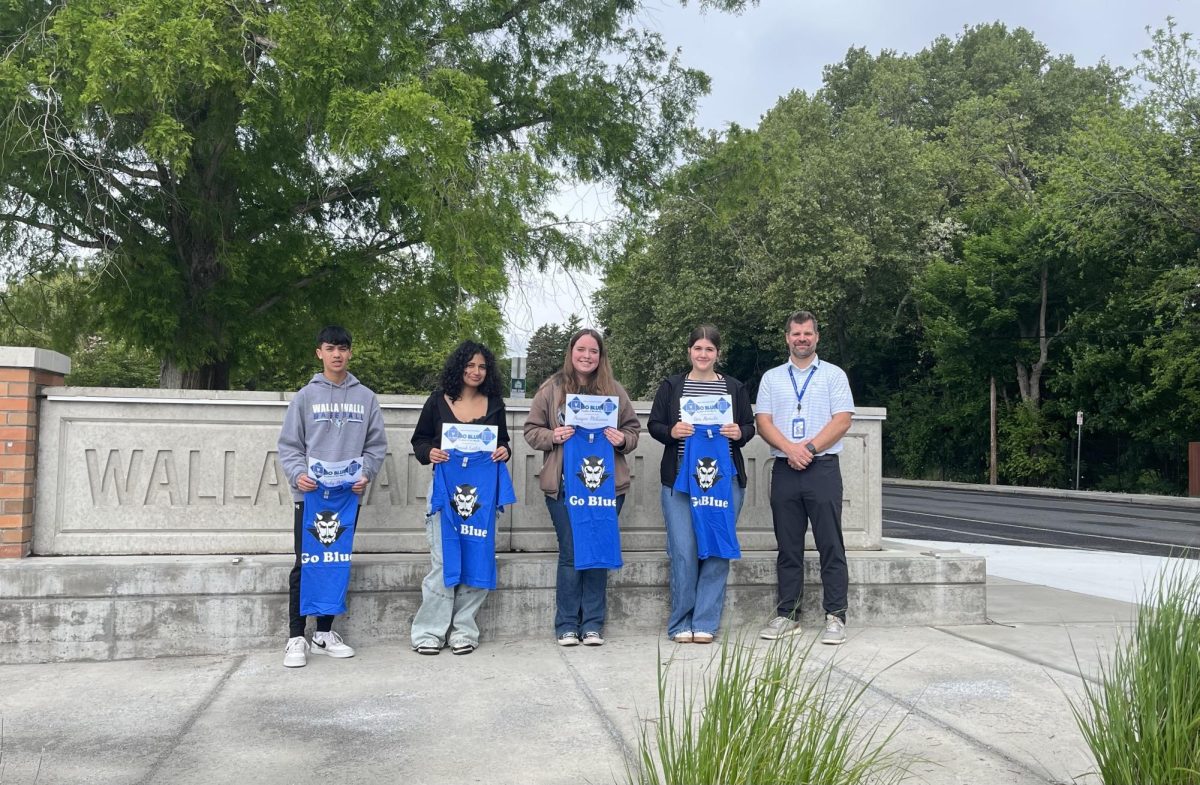The cheer team of Walla Walla High School is known for their showy stunts, active school involvement, hard work and dedication to the sport, and prized ‘Holla for Walla Walla’ cheer. While everyone sees the well-executed performances and hears the announcements of the team’s place at State competition every year, the work, sweat, struggle, and two-hour practices are concealed behind the curtain of success. To spread the word about what happens behind the scenes, I interviewed the coaches who run it all, acquiring strong rapport and praise for the team.
On Thursday, November 21st, I met with cheer coaches Morgan Arreola and Katylyn Romero to voice their thoughts on the current season. As I’m on the cheer team and they already know who I am, I began the interview by thanking them for setting time aside from their practice-packed schedules.
I adjusted my position to make myself comfortable, easing my way into the durable foam black mat of the upstairs WA-HI weight room, where the winter cheer team practices are held. Clearing my throat, I asked my first question: “What is your favorite part of being cheer coach?”
Morgan eagerly jumped in to share her response, her eyes and face lighting up with pride as she talked. She explained that she loves it when a stunt group is struggling and she can figure out the “missing puzzle piece” to solve the issue and help that group hit that stunt. She expressed her delight in knowing what to do as a coach and getting to be a part of achieving wins for people on the team; that is the best part of being cheer coach in her opinion.
After some thought, Katy offered her reply, stating that her favorite part of being cheer coach is getting to watch the team perform and seeing dances and stunt sequences come together. For her, success is all about the hard work of the team paying off and reflecting at showtime.
For context, the cheer team performs at a myriad of events: city parades, football games, school assemblies, wrestling matches, basketball games, and competitions throughout the state, and other ASB events. These performances raise school spirit and add to the excitement of the gathering.
After I finished briskly typing my notes, I paused to read my next question: “As coaches, what are you looking forward to this season?”
Again, Morgan was the first to respond, igniting a taste of her passion for the sport. She profused her enthusiasm for having enough people interested in the sport to grow the program to two distinct cheer teams – the fall team and the winter team – and that because so many people tried out, she was able to make the dream come to fruition.
Katy soon followed Morgan’s response, taking it in a similar direction. She said that she is looking forward to feeling more confident as a coach, as it is her second year leading the team. Adding on to that, she mentioned that she’s ready to take charge of the winter team and watch them grow. Even though Katy assists with the responsibilities of the fall team, she’s in charge of the winter team and can’t wait to see where they go.
My third question branched off their replies regarding the division of one cheer team into two teams, adding a conversational element to the interview. “This year, the team split into two divisions: fall cheer and winter cheer. Could you please elaborate on why you made that choice, how it affects the team, and the benefits it brings to the athletes?” I curiously inquired, as I was wondering about this new decision.
To continue the pattern, Morgan was the first to share her thoughts. She reinforced that the primary reason was to grow the team. She built on this initial thought by saying that it’s important to her that people are involved in the sports programs at WA-HI, however, many athletes are already committed to one sport so that decreases the eligibility of people who can participate in cheer. To combat this, she split the team into two so people who are playing a fall sport can partake in winter cheer and vice versa. Additionally, having two teams allows people who don’t want to compete to have an option for them. Overall, for her, it’s all about increasing opportunities for everyone.
Katy seconded Morgan’s train of thought, restating that the main reason was to build opportunities for athletes. In addition, she noted that having two teams prevents burnout, as athletes have half a season’s activities taken off their plate. Katy also commented on her excitement to be more present in winter sports. In the past, cheer was centered around cheering at football games and performing at competitions. Now, the team can engage more with basketball and wrestling, increasing their participation in cheering for sports.
To increase understanding, this year the fall cheer team is involved in football events, fall assemblies, and competitions; the winter team is a part of basketball and wrestling events and winter assemblies.
Finally, as I wrapped up that section of my notes, I prepared to ask my last question that uncovers the strategies and efforts to bring the best cheer season possible: “What are new practices that you are implementing to make the cheer team stronger and better this year?”
This question began with a pause, allowing the question to settle into their minds before being verbalized. Morgan answered first, providing a plethora of new activities to better the team. She stated that this year there are more opportunities to succeed because she hired Robb Webb, a stunt coach, and a choreographer for the dance for competitions. She has never hired a choreographer, so she thinks this change will benefit the performance of the team. In addition, she wants to vocalize individual achievements and recognize and reward athlete success. Morgan added that she wants to keep people accountable to their word and the areas they said they wanted to improve in. Similarly, she created a partner system – Breakdown Buddies – to debrief struggles of cheer and get things off their chest to prevent burnout. Additionally, this will foster a sense of community between the athletes and help build relationships. Morgan also shared that she increased opportunities and options for the athletes so they don’t feel like they’re going to fail.
After waiting a moment to collect her response, Katy declared that the warm-ups will be tougher to build strength in the athletes and prepare them for the upcoming practice. She also mentioned that this year, mental health is going to be a priority, making adjustments such as having longer practices less periodically.
As I concluded my notes, I thanked Morgan and Katy once again for carving out time to be interviewed. Because the interview followed a practice, I thirstily guzzled a drink from my water bottle and then gathered my belongings before heading out.
The cheerleaders of Walla Walla High School are revered for their performance competitions, but the work they put in is often overlooked. In admiration and respect for the cheer team, I look forward to seeing how the team grows and thrives under the changes and opportunities this season brings. I have no doubt that the cheer team is going to blossom and bloom this year, especially now that I have an understanding of why Morgan and Katy made the decisions they chose to make and the impact the role of cheer coach has had on them. To close, I hope you all leave with a clarified understanding of the input and forethought put into the cheer team.












